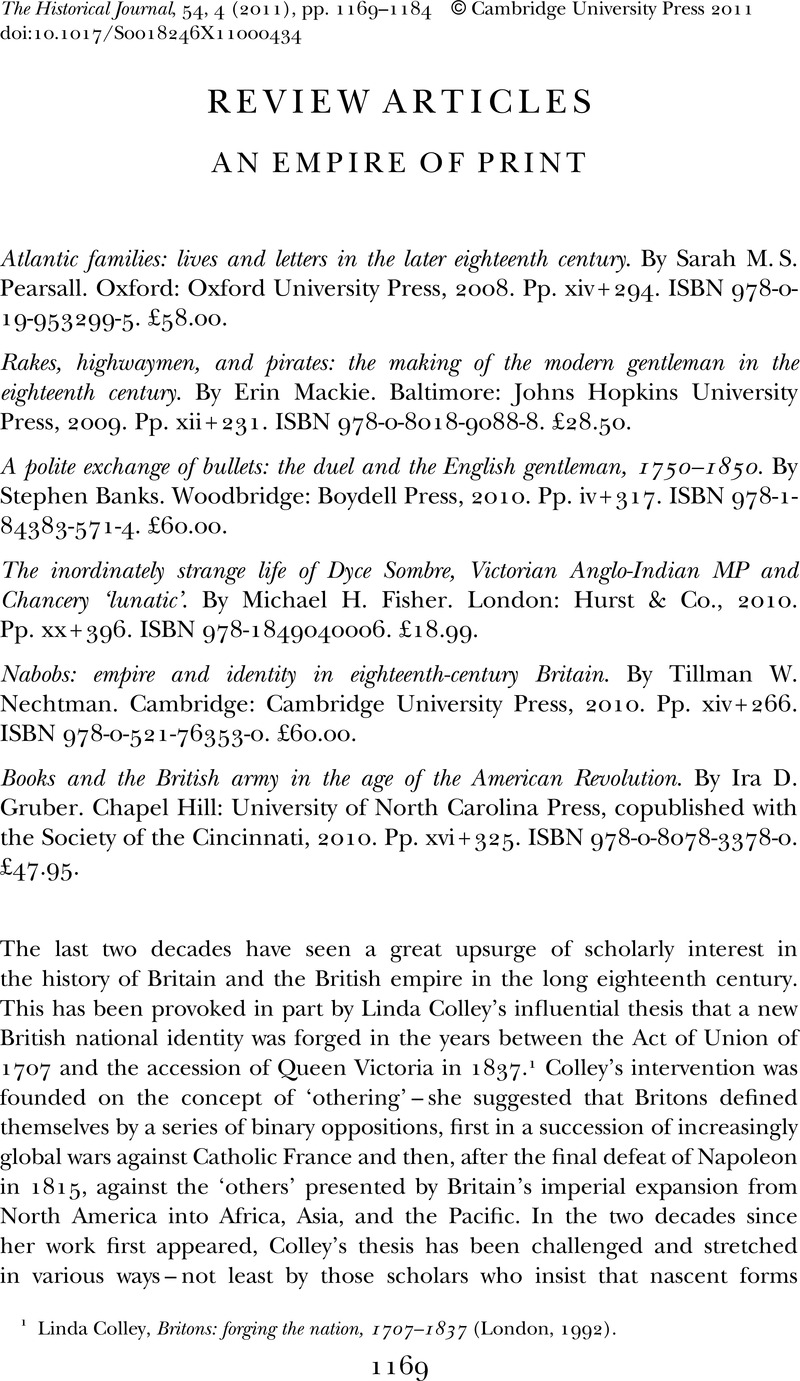No CrossRef data available.
Published online by Cambridge University Press: 07 November 2011

1 Colley, Linda, Britons: forging the nation, 1707–1837 (London, 1992)Google Scholar.
2 See, for example, Claydon, Tony and McBride, Ian, eds., Protestantism and national identity: Britain and Ireland, c. 1650 – c. 1850 (Cambridge, 1998)CrossRefGoogle Scholar; Eagles, Robin, Francophilia in English society, 1748–1815 (Basingstoke, 2000)CrossRefGoogle Scholar; Kidd, Colin, Subverting Scotland's past: Scottish Whig historians and the creation of an Anglo-British identity, 1689 – c. 1830 (Cambridge, 1993)CrossRefGoogle Scholar; idem, British identities before nationalism: ethnicity and nationhood in the Atlantic world, 1600–1800 (Cambridge, 1999); Wilson, Kathleen, The sense of the people: politics, culture and imperialism in England, 1715–1785 (Cambridge, 1995)Google Scholar; idem, The island race: Englishness, empire and gender in the eighteenth century (London, 2003).
3 Wilson, Kathleen, ed., A new imperial history: culture, identity and modernity in Britain and the empire, 1660–1840 (Cambridge, 2004)Google Scholar; see also Daunton, Martin and Halpern, Rick, eds., Empire and others: British encounters with indigenous peoples, 1600–1850 (Philadelphia, PA, 1999)Google Scholar; Hall, Catherine, ed., Cultures of empire: colonizers in Britain and the Empire in the nineteenth and twentieth centuries (Manchester, 2000)Google Scholar; Howe, Stephen, ed., New imperial histories reader (London, 2009)Google Scholar.
4 Teltscher, Kate, India inscribed: European and British writing on India, 1600–1800 (Oxford, 1995), p. 7Google Scholar.
5 Brubaker, Rogers and Cooper, Frederick, ‘Beyond “identity”’, Theory and Society, 29 (2000), pp. 1–47CrossRefGoogle Scholar.
6 Mandler, Peter, ‘What is “national identity”? Definitions and applications in modern British historiography’, Modern Intellectual History, 3 (2006), pp. 271–97CrossRefGoogle Scholar (p. 272).
7 Wilson, ed., New imperial history, p. 6.
8 For the term ‘self-fashioning’, see Greenblatt, Stephen, Renaissance self-fashioning: from More to Shakespeare (Chicago, IL. 1980)Google Scholar.
9 Wahrman, Dror, ‘The English problem of identity in the American Revolution’, American Historical Review, 106 (2001)CrossRefGoogle Scholar, par.3 <http://www.historycooperative.org/journals/ahr/106.4/ah0401001236.html> (23 July 2011).
10 Wahrman, Dror, The making of the modern self: identity and culture in eighteenth-century England (New Haven, CT, 2004), p. xvGoogle Scholar.
11 See, for instance, , Wilson, Sense of the people; Teltscher, India inscribed; Linda Colley, Captives: Britain, empire, and the world, 1600–1850 (London, 2002)Google Scholar; Lepore, Jill, The name of war: King Philip's war and the origins of American identity (New York, NY, 1998)Google Scholar; Nussbaum, Felicity, Torrid zones: maternity, sexuality and empire in eighteenth-century English narrative (Baltimore, MD, 1995)Google Scholar; Hunt, Margaret, ‘Racism, imperialism and the traveller's gaze in eighteenth-century England’, Journal of British Studies, 32 (1993), pp. 333–57CrossRefGoogle Scholar; Logan, Deborah A., Harriet Martineau, Victorian imperialism, and the civilising mission (Farnham, 2010)Google Scholar.
12 For an earlier discussion of epistolary uses of Pamela in the Atlantic context, see Landsman, Ned C., From colonials to provincials: American thought and culture, 1680–1760 (New York, NY, 1997)Google Scholar, especially pp. 134–9.
13 Andrew, Donna T., ‘The code of honour and its critics: the opposition to duelling in England, 1700–1850’, Social History, 5 (1980), pp. 409–34CrossRefGoogle Scholar; Kiernan, V. G., The duel in European history: honour and the reign of the aristocracy (Oxford, 1988)Google Scholar; Shoemaker, Robert B., ‘The taming of the duel: masculinity, honour and ritual violence in London, 1660–1800’, Historical Journal, 45 (2002), pp. 525–45CrossRefGoogle Scholar; Manning, Roger B., Swordsmen: the martial ethos in the three kingdoms (Oxford, 2003)Google Scholar.
14 Fisher, Michael, Counterflows to colonialism: Indian travellers and settlers in Britain, 1600–1857 (Delhi, 2004)Google Scholar.
15 Authoritative studies of the conjectural history of the Scottish Enlightenment include Berry, Christopher J., The social theory of the Scottish Enlightenment (Edinburgh, 1997)Google Scholar; Bryson, Gladys, Man and society: the Scottish inquiry of the eighteenth century (Princeton, NJ, 1945)CrossRefGoogle Scholar; Spadafora, David, The idea of progress in eighteenth-century Britain (London, 1990)Google Scholar.
16 Allan, David, ‘Anti-Hispanicism and the construction of late eighteenth-century British patriotism: Robert Watson's History of the reign of Philip the Second’, Bulletin of Hispanic Studies, 77 (2000), pp. 423–49CrossRefGoogle Scholar.
17 Pocock, J. G. A., Barbarism and religion (5 vols. Cambridge, 2000–11)Google Scholar.
18 For influential models of female patriotism taken from classical history, see O'Brien, Karen, Women and enlightenment in eighteenth-century Britain (Cambridge, 2009)CrossRefGoogle Scholar.
19 Compare, for instance, Bayly, Christopher A., Imperial meridian: the British empire and the world, 1780–1830 (London, 1989)Google Scholar; idem, Indian society and the making of the British empire (Cambridge, 1988); Simms, Brendan, Three victories and a defeat: the rise and fall of the first British empire, 1714–1783 (London, 2007)Google Scholar.
20 Kaufman, Paul, Libraries and their users: collected papers in library history (London, 1969)Google Scholar; Allan, David, ‘A nation of readers’: the lending library in Georgian England, c. 1720 – c. 1830 (London, 2008)Google Scholar; Raven, James, London booksellers and American customers: transatlantic literary community and the Charleston Library Society, 1748–1811 (Columbia, OH, 2002)Google Scholar; Towsey, Mark, Reading the Scottish Enlightenment: books and their readers in provincial Scotland, 1750–1820 (Leiden, 2010)CrossRefGoogle Scholar.
21 Important contributions include Allan, David, Making British culture: English readers and the Scottish Enlightenment, 1740–1830 (London, 2008)Google Scholar; Chartier, Roger, The order of books: readers, authors, and libraries in Europe between the fourteenth and eighteenth centuries, trans. Lydia G. Cochrane (Cambridge, 1994)Google Scholar; Colclough, Stephen, Consuming texts: readers and reading communities, 1695–1870 (Basingstoke, 2007)CrossRefGoogle Scholar; Darnton, Robert, ‘First steps toward a history of reading’, Australian Journal of French Studies, 23 (1986), pp. 5–30CrossRefGoogle Scholar; Fergus, Jan, Provincial readers in eighteenth-century England (Oxford, 2006)Google Scholar; Raven, James, Small, Helen, and Tadmor, Naomi, eds., The practice and representation of reading in England (Cambridge, 1996).Google Scholar
22 David McKitterick, ‘Book catalogues: their varieties and uses’, in Peter Davidson, ed., The book encompassed: studies in twentieth-century bibliography (Cambridge, 1992), p. 166.
23 Particularly pertinent recent contributions include van Buskirk, Judith L., Generous enemies: patriots and loyalists in revolutionary New York (Philadelphia, PA, 2003)Google Scholar; Conway, Stephen, ‘The British army, “Military Europe”, and the American War of Independence’, William and Mary Quarterly, 3rd ser., 68 (2010), pp. 69–100CrossRefGoogle Scholar; Knott, Sarah, ‘Sensibility and the American War for Independence’, American Historical Review, 109 (2004), pp. 19–40CrossRefGoogle Scholar.